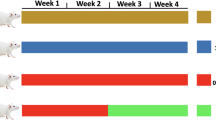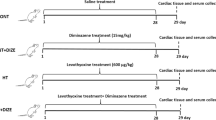Abstract
Hyperthyroidism sensitizes the heart for reperfusion injury. As known, mitochondrial permeability transition underlies reperfusion heart damage. This study was undertaken to explore the protective effect of octylguanidine (OG), an inhibitor of permeability transition, on hearts from hyperthyroid rats subjected to ischemia/reperfusion. Hyperthyroidism was induced by a daily injection of 2 mg T3/kg body weight for 5 days. OG was injected at a dose of 5 mg/kg body weight. It was found that the amine protects against reperfusion-induced permeability transition, i.e., mitochondria from hyperthyroid rats, treated with OG, retained accumulated Ca2+, similarly to control mitochondria. OG maintained post reperfusion cardiac frequency in hyperthyroid rats at 429 ± 16 in comparison to control and T3 treated rats (70 ± 12 and 71 ± 2, respectively). We also found that OG diminished the post reperfusion accumulation of IFNγ from 34.3 ± 2.5 to 18.7 ± 1.35, IL-6 from 38.5 ± 4.5 to 15.1 ± 0.12, IL-1 from 16.78 ± 0.73 to 12.19 ± 1.54, and TNFα from 45.05 ± 3.14 to 29.85 ± 4.3 (pg/50 μg myocardial tissue). It is concluded that OG inhibits the hypersensitivity of the hyperthyroid myocardium to undergo reperfusion damage due to its inhibitory action on the permeability transition pore.




Similar content being viewed by others
References
K.A. Woeber, Thyrotoxicosis and the heart. N. Engl. J. Med. 327, 94–98 (1992)
I. Klein, G.S. Levey, The Cardiovascular System in Thyrotoxicosis, in The Thyroid, 8th edn., ed. by L.E. Braveman, R.D. Utiger (Lippicott-Raven, Philadelphia, 2000), pp. 596–604
T.M. Pillar, H.J. Seitz, Thyroid hormone and gene expression in the regulation of mitochondrial respiratory function. Eur. J. Endocrinol. 136, 231–239 (1997)
P. Venditti, S. Di Meo, Thyroid hormone-induced oxidative stress. Cell Mol. Life Sci. 63, 414–434 (2006)
U.M. Schmidt-Ott, D.D. Ascheim, Thyroid hormone and the heart failure. Curr. Heart Fail. Rep. 3, 114–119 (2006)
P. Venditti, A. Bari, L. Di Stefano, C. Agnisola, S. Di Meo, Effect of T3 treatment on the response to ischemia-reperfusion of heart preparations from sedentary and trained rats. Pflugers Arch. 455, 667–676 (2008)
P. Masullo, P. Venditti, C. Agnisola, S. Di Meo, Role of nitric oxide in the reperfusion induced injury in hyperthyroid rat hearts. Free Radic. Res. 32, 411–421 (2000)
Y. Kusana, M. Bernier, D.J. Hearse, Exacerbation of reperfusion arrhythmias by sudden oxidant stress. Circ. Res. 67, 481–489 (1990)
N.S. Dhalla, L. Golfman, S. Takeda, N. Takeda, M. Nagano, Evidence of oxidative stress in acute ischemic heart disease: a brief review. Can. J. Cardiol. 15, 587–593 (1999)
W.W. Brooks, C.H. Conrad, J.P. Morgan, Reperfusion induced arrhythmias following ischemia in intact rat heart: role of intracellular calcium. Cardiovasc. Res. 29, 536–542 (1995)
G.J. García-Rivas, K. Carvajal, F. Correa, C. Zazueta, Ru360, a specific mitochondrial calcium uptake inhibitor, improves cardiac post ischemic functional recovery in rats in vivo. Brit. J. Pharm. 149, 1188–1196 (2006)
A.P. Halestrap, S.J. Clarke, S.A. Javadov, Mitochondrial permeability transition pore opening during myocardial reperfusion—a target for cardioprotection. Cardiovasc. Res. 61, 372–385 (2004)
T. Wajima, S. Shimizu, T. Hirió, M. Ishii, Y. Kiuchi, Reduction of myocardial infarct size by tetrahydrobiopterin: possible involvement of mitochondrial KATP channels activation through nitric oxide production. J. Cardiovasc. Pharmacol. 47, 243–249 (2006)
E. Chávez, M. Franco, H. Reyes-Vivas, C. Zazueta, J. Ramírez, R. Carrillo, Hypothyroidism renders liver mitochondria resistant to the opening of membrane permeability transition pore. Biochim. Biophys. Acta 1407, 243–248 (1998)
I. Bobadilla, M. Franco, D. Cruz, J. Zamora, S.G. Robles, E. Chávez, Hypothyroidism provides resistance to reperfusion injury following myocardium ischemia. Int. J. Biochem. Cell. Biol. 33, 499–506 (2001)
M. Schlame, K.Y. Hostetler, Cardiolipin synthase from mammalian mitochondria. Biochim. Biophys. Acta 1348, 207–213 (1997)
K. Dummier, S. Muller, H.J. Seitz, Regulation of adenine nucleotide translocase and glycerol 3-phosphate dehydrogenase expression by thyroid hormones in different tissues. Biochem. J. 317, 913–918 (1996)
S.G. Robles, M. Franco, C. Zazueta, N. García, F. Correa, G. García, E. Chávez, Thyroid hormone may induce changes in the concentration of the mitochondrial calcium uniporter. Comp. Biochem. Physiol. B Biochem. Mol. Biol. 135, 177–182 (2003)
V. Kalderon, O. Hermesh, J. Bar-Tana, Mitochondrial permeability transition is induced by in vivo thyroid hormone treatment. Endocrinology 136, 3552–3556 (1995)
A.D. Toft, N.A. Boon, Thyroid disease and the heart. Heart 84, 455–466 (2000)
P. Venditti, C. Agnisola, S. Di Meo, Effect of ischemia-reperfusion on heart mitochondria from hyperthyroid rats. Cardiovasc. Res. 56, 76–85 (2002)
R.F. Castilho, A.J. Kowaltoski, A.E. Vercesi, 3,5,3’-triiodothyronine induces mitochondrial permeability transition mediated by reactive oxygen species and membrane thiol oxidation. Arch. Biochem. Biophys. 354, 151–157 (1998)
A.S. Araujo, M.F. Ribeiro, A. Enzveiler, P. Schenkel, T.R. Fernández, W.A. Partada, M.C. Irigoyen, S. Llesuy, A. Belló-Klein, Myocardial antioxidant enzyme activities and concentration and glutathione metabolism in experimental hyperthyroidism. Mol. Cell. Endocrinol. 249, 133–139 (2006)
F. Di Lisa, P. Bernardi, Mitochondria and ischemia-reperfusion injury of the heart: fixing a hole. Cardiovasc. Res. 70, 191–199 (2006)
P. Bernardi, Mitochondrial transport of cations: Channels, exchangers, and permeability transition. Physiol. Rev. 79, 1127–1155 (1999)
E. Chávez, A. Peña, C. Zazueta, J. Ramírez, N. García, R. Carrillo, Inactivation of mitochondrial permeability transition by octylguanidine and octylamine. J. Bioenerg. Biomembr. 32, 193–198 (2000)
E. Parra, D. Cruz, G. García, C. Zazueta, F. Correa, N. García, E. Chávez, Myocardial protective effect of octylguanidine against the damage induced by ischemia reperfusion in rat heart. Mol. Cell. Biochem. 269, 19–26 (2005)
M. Klingenberg, Molecular aspects of the adenine nucleotide carrier from mitochondria. Arch. Biochem. Biophys. 270, 1–14 (1989)
D. Arteaga, A. Odor, R.M. López, G. Contreras, J. Pichardo, E. García, A. Aranda, E. Chávez, Impairment by cyclosporin A of reperfusion-induced arrhythmias. Life Sci. 51, 1127–1134 (1992)
F. Correa, V. Soto, C. Zazueta, Mitochondrial permeability transition relevance for apoptotic triggering in the post-ischemic heart. Int. J. Biochem. Cell. Biol. 39, 787–798 (2007)
L. Lanoye, P. Segers, V. Tchna-Sato, S. Rolin, J.M. Dogne, A. Guisen, B. Labernot, J. Hanson, T. Desaire, P. Verdonck, V. D’orio, P. Kolh, Cardiovascular control: cardiovascular haemodynamics and ventriculo-arterial coupling in an acute pig model of coronary ischemia-reperfusion. Exp. Phys. 92, 127–139 (2007)
S.Y. Ngo, H.C. Chew, When the storm passes unnoticed—a case series of thyroid hormone. Resuscitation 73, 485–490 (2007)
M. Wang, B.M. Tsai, P.R. Crisostomo, D.R. Meldrum, Tumor necrosis factor receptor 1 signaling resistance in the female myocardium during ischemia. Circulation 114, 1282–1289 (2006)
G. Gallagher, S. Menzie, Y. Huang, C. Jackson, S.N. Hunyor, Regional cardiac dysfunction is associated with specific alterations in inflammatory cytokines and matrix metalloproteinases after acute myocardial infarction in sheep. Basic Res. Cardiol. 102, 63–72 (2007)
A. Siddiqi, J.P. Monson, D.F. Wood, G.M. Basser, J.M. Burrin, Serum cytokines in thyrotoxicosis. Clin. Endocrinol. Metab. 84, 435–439 (1999)
G. Hasko, D.G. Kuhgel, A. Marton, Z.H. Nemeth, E.A. Deitch, C. Szabó, Spermine differentially regulates the production of interleukin-12 p40 and interleukin-10 and suppresses the release of the helper 1 cytokine interferon-gamma. Shock 14, 144–149 (2000)
R. Phillips, H. Clarke, The preparation of alkylguanidines. J. Am. Chem. Soc. 45, 1755–1757 (1923)
E. Chávez, F. Téllez, J. Pichardo, R. Milán, A. Cuellar, K. Carvajal, D. Cruz, On the protection by ketorolac of reperfusion-induced heart damage. Comp. Biochem. Physiol. 115C, 95–100 (1996)
E.A. Palmieri, G. Benincasa, F. Di Rella, C. Casaburi, M.G. Monti, G. De Simona, L. Chiarotti, L. Palombini, C.B. Bruni, L. Sácala, A. Cittadini, Differential expression of TNF-α, IL-6, and IGF-1 by graded mechanical stress in normal rat myocardium. Am. J. Physiol. 282, H925–H934 (2002)
F.J. Neumann, L. Ott, M. Gawaz, H. Holzaptel, M. Jochum, A. Schomig, Cardiac release of cytokines and inflammatory responses in acute myocardial infarction. Circulation 92, 748–755 (1995)
O.H. Lowry, N.J. Rosebrough, A.L. Farr, R.J. Randal, Protein measurement with the folin phenol reagent. J. Biol. Chem. 193, 262–275 (1951)
Acknowledgment
The authors acknowledge the helpful expertise of Dr. Roberto Arreguín, from the Instituto de Química, UNAM, to verify the purity and mass of octylguanidine.
Author information
Authors and Affiliations
Corresponding author
Rights and permissions
About this article
Cite this article
Pavón, N., Aranda, A., García, N. et al. In hyperthyroid rats octylguanidine protects the heart from reperfusion damage. Endocr 35, 158–165 (2009). https://doi.org/10.1007/s12020-008-9144-0
Received:
Accepted:
Published:
Issue Date:
DOI: https://doi.org/10.1007/s12020-008-9144-0




